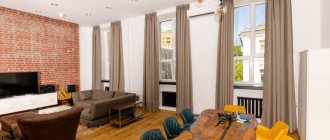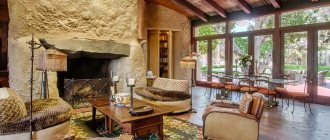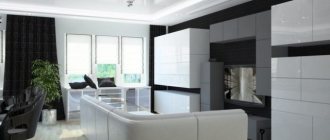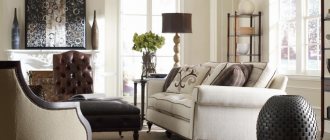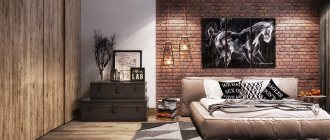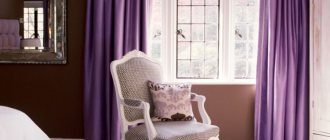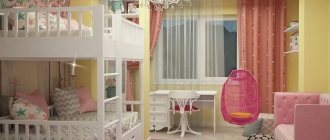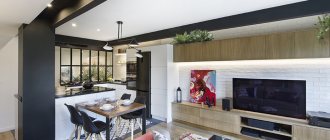Historical styles
Such styles in the interior are understood as trends, the emergence of which occurred naturally under the influence of various historical events. Let's look at them in order of appearance:
Baroque
The beginning of the 17th century was the heyday of royal interiors. The Baroque style in the interior is luxurious: it is distinguished by lush decor, a wide range of room dimensions, and a desire for grandeur. Wealth was literally put on display, hence the abundance of gilding, stucco, furniture made of precious wood, handwritten paintings, and frescoes.
In modern conditions, Baroque seems too pretentious: besides, it is impossible to play it in an ordinary apartment: the palace style requires suitable space.
Classicism
Contrary to the overly simulated Baroque, a classical direction in design appeared in the early 1600s: it affected not only the interior, but also painting, music, and architecture.
Classics are distinguished by strict forms, symmetry, and functionality. Although signs of the Baroque, such as high ceilings, expensive materials and chic decor, still remain, classicism is more about grandeur than pretense.
Nowadays this direction is traditional. It still strives for antiquity and does not follow fashion. Suitable for those who value a combination of luxury and comfort.
Colonial
Literature
- Dodsworth S.
Fundamentals of interior design: textbook = The Fundamentals of Interior Design / trans. A. Mazurova, D. D. Shevchenko, K. Makarova. - M.: Tride Cooking, 2011. - 184 p. - (Design). — ISBN 978-5-904011-05-5. - Zmanovskikh E.V.
[dlib.rsl.ru/viewer/01003484331#?page=1 Artistic techniques and technological means in the interior design of public buildings] / abstract of thesis. ... candidate of technical sciences: 17.00.06. - SPb.: St. Petersburg. state University of Technology and Design, 2009. - 20 p. - Mitrofanova E. V.
Interior design of restaurant establishments in Russia at the end of the 19th and beginning of the 21st centuries / dissertation ... candidate of art history: 24.00.01. — Yaroslavl: Yaroslav. state ped. University named after K. D. Ushinsky, 2006. - 231 p. - Pyle D.
6000 years of history of architecture and design. History of interior design = A History of Interior Design / trans. from English O. I. Sergeeva. - M.: Astrel, 2011. - 463 p. — 1250 copies. — ISBN 978-5-271-38367-0. - Pankratova A.V.
Interior design as a semiotic structure: dissertation ... candidate of philosophical sciences: 24.00.01. — Smolensk: Nizhegorsk. state architecture-builds univ., 2007. - 178 p. - Protopopov V.V.
Interior design: (Theory and practice of organizing home interior). - M., Rostov n/D: March, 2004. - (Architectural education). — ISBN 5-241-00358-4. - Pyankova N. S.
[dlib.rsl.ru/viewer/01005015016 Neo-rationalistic methods of shaping in interior design of the 2000s] / abstract of thesis. ... candidate of art history: 17.00.06. — Ekaterinburg: Ur. state architectural-art. acad., 2012. - 20 p. - Svestelnik Z.V.
Cultural traditions in modern Chinese interior design: (on the example of restaurants of national cuisine). — Blagoveshchensk: Amur State. univ., 2010. - 151 p. — ISBN 978-5-93493-141-5. - Sofieva N. I.
[search.rsl.ru/ru/record/01005436283 Interior design: styles, trends, materials]. - M.: Eksmo, 2012. - 655 p. — (Interior and home improvement). — ISBN 978-5-699-53064-9. - Tretyakova M. S.
[dlib.rsl.ru/viewer/01005012561 Principles of traditional Japanese “aesthetics of transience” in modern interior design] / abstract of the thesis ... candidate of art history: 17.00.06. - Ekaterinburg: Level of State Architectural and Artistic Acad., 2012. - 21 p.
Ethnic styles
The culture of each ethnic group has its own distinctive characteristics: this is expressed in painting, literature, traditional food and, of course, home decoration.
English
England is famous for its traditions and the interior style is no exception. The traditional English style, known today, was formed in the 19th century. Although the origins of the direction go back to the 16th-17th centuries, which coincided with the heyday of the Victorian era.
The interiors are as prim and reserved as their owners. Wood is considered the main material - it is used to create furniture, in the design of walls, floors, and ceilings. Small floral prints are also popular in upholstery or decoration: they can also be seen in textiles (curtains, pillows).
French (Provence)
Although the French are the founders of many styles, the image of the French village - Provence - is most associated with their way of life. It gains unique lightness due to light shades (white, beige, pastel), floral prints, and cute decor.
As in any rural interior, there is a lot of wood in Provence: but not in a natural “heavy” shade, but as light as possible - mostly white. Furniture, as in shabby, has the right to be shabby: marks of time make the space more cozy and homely.
Mediterranean
Every part of the Mediterranean interior is saturated with salty air, hot sun, and warm sea water. Thus, many countries have access to the sea; the style is divided into European (Greece, Spain, Italy) and eastern (Tunisia, Algeria, Turkey). The directions are radically different, but in the classical sense, the Mediterranean style is European.
The color scheme is light (white, blue, sand, with blue and red details). The main goal is to make the space bright and allow the sun to penetrate inside the house. To do this, the walls and ceiling are left in white colors - this color reflects and doubles the flow of sunlight.
Japanese
Japanese homes resemble their owners: structured, clean, functional. The style is characterized by minimalism - natural, discreet shades, a small amount of simple furniture.
Furniture stands out primarily for its height: the Japanese prefer low tables, at which they sit on equally low chairs or cushions. You can avoid the bed altogether by placing the mattress directly on the floor.
The second feature is unity with nature. The desire to be closer is expressed in the presence of doors from an apartment or house directly to the garden, as well as in the cultivation of bonsai and other flowers.
Chinese
Although Japanese and Chinese styles are Eastern, there is a huge difference between them. The first nuance that immediately sets a Chinese house apart from the list of others is the wooden grilles. Wood patterns decorate walls, furniture, ceilings, lamps, doors, and windows.
The second sign is a red light. The Chinese believe that it brings good luck, so they actively use it in their interiors.
The third point is the ceiling. In China, they are traditionally made multi-level, using luminous panels or lighting around the perimeter.
African
Certain elements of the style were actively used in the colonial direction, but interiors in the African style are good in themselves. The shades are warm, natural, muted: yellow, orange, red, green, beige. Black and brown are used for accents.
Wicker furniture, bamboo, animal prints and designs are trendy. Masks, drums, idols, chests, and ceramics are used for decoration.
Indian
As colorful as the country itself is, so are its interiors. Indian design is characterized by the use of bright shades of yellow, red, terracotta, blue, green, combined with wood texture and oriental prints.
Traditional patterns are “cucumbers”, symmetrical mandalas, flowers and birds: patterns are used on wallpaper, upholstery, and textiles. The latter, by the way, should be a lot: especially decorative pillows.
In addition to pillows, houses are decorated with carpets, Buddhist figurines, chests, carved screens, and comfortable poufs.
Russian
As in France, the most visual style in Russia is considered to be rustic. The differences between Russian country music can be seen in paintings, films, and cartoons: a wood-burning stove, wooden walls, carved shutters, embroidered or lace textiles (tablecloths, curtains, towels), homespun carpets.
The color palette is warm: yellow, orange, red goes well with natural wood.
Classic style
Interior design in a classic style can be described as solemn and restrained and conservative, but at the same time lively and cozy. He is characterized by harmony, nobility and impeccable taste, which he borrowed from the ancient style, expressing them in his own way. The classic style is suitable for decorating spacious, bright rooms, in which there is room for columns, arches, a fireplace, massive furniture and chandeliers. The classic interior serves as evidence of the high social status, respectability and wealth of the apartment owner.
Key features inherent in the classical style
- clarity of lines, proportionality of shapes, thought through every detail;
- the presence of furniture made of solid wood - white with gilding or the natural color of noble wood with bronze elements;
- the use of classical columns and half-columns, stucco moldings, elegant crystal or bronze chandeliers, curtains and draperies, mirrors, antique accessories, and paintings as decorative elements;
- warm, pastel, noble, deep colors;
- a variety of natural fabrics with classic patterns, tassels, tapestries;
- expensive decorative materials - wood, stone, marble;
- parquet floors with expressive patterns;
- key shapes are oval and circle.
Characteristic colors
- white;
- gold;
- pale yellow;
- cream;
- beige-brown;
- green;
- terracotta;
- chocolate.
Mixed styles
Few interiors today can be called “pure”: over the course of history, styles are mixed in one way or another, adopting each other’s features, and forming new directions. For example, Japandi, discussed in the first section, combines characteristics of Nordic and Japanese design.
But there are also trends that combine many styles at once:
Eclecticism
The main feature of an eclectic interior is that it can be different. Combine both similar and opposite designs. For example, a combination of Asian and European, vintage and trendy. In this case, the mixing does not occur chaotically.
All elements have a certain criterion by which they are combined: color, texture, style.
To avoid fragmentation and not spoil the idea, designers advise using a maximum of 3 styles and 4 colors as a basis: this way, each element will be in its place.
Fusion
From English the term is translated as fusion, which best describes his philosophy. The style originated in the 90s of the 20th century under the influence of globalization: it can be called a logical continuation of the colonial direction. At this moment, exotic oriental and African elements poured into the familiar European and American interiors.
The main rule of fusion is no rules! The finished spaces are multi-layered, bright, ambiguous: they combine not styles, as in eclecticism, but individual elements. For example, a carved baroque chair easily coexists with a modern frameless sofa and a fashionable coffee table.
We have analyzed, if not all, the most relevant design trends today. Use styles in their pure form or combine them with each other: the main thing is that you feel comfortable!
Scandinavian style
The interior in the Scandinavian style betrays the character of the northern peoples, who, despite all their coldness and severity, value home comfort, the warmth of the hearth, and the joyful colors of nature.
Features of Scandinavian style
- simplicity and roughness of forms;
- use of natural materials: wood, stone, metal, glass, leather, fur, flax, cotton, ceramics;
- simple and practical furniture made of light wood with natural upholstery;
- good natural light, facilitated by large windows and translucent curtains or their complete absence;
- floors, window and door openings are wooden, light in color, walls are plain, white or light, trimmed with wood panels or plaster;
- a minimum of decor, all accessories are simple and bright, handmade items are popular;
- the room is decorated with glass or ceramic vases, bright textiles (pillows, rugs, covers), live plants, photographs, paintings of natural or marine themes, mirrors, and a variety of expressive lamps.
Colors
- main color – white and all its shades;
- the predominance of pastel colors: beige, light brown, soft green, blue, gray, turquoise;
- bright accents - blue, red, green, amber-yellow.
Important elements: walls, prints and retro finishes
Modern retro style is materials and furniture made today, stylized as products of that time. Some of the requirements of this style are high quality materials, good finishing, and neat work. It is for this reason that retro can be confused with vintage. However, vintage is a style that does not imply stylized, but original elements of that time. In other words, if you can buy furniture, wallpaper or other retro-style items in a regular store, then most vintage items will be sold in an antique store.
Bright (sometimes to the point of acidity) colors combined with precise, absolutely thought-out lines of furniture or drawings. No picture frames, abstract color or black and white prints, lacquered surfaces and gloss. This can be attributed to the main features of retro, which is still popular today. For a standard apartment in a multi-storey building, this is one of the universal options for choosing a style. If you love antiques, you know that styles that date back to earlier periods require breadth and scope. And this is precisely where we are all, as a rule, limited.
We can say that retro is a kind of thoughtful chic. Beauty is where you can afford it, and no more. For example, the walls can be painted with a single color paint or covered with wallpaper with a small or medium repeating pattern. Many finishing elements are not about retro. It's more of a play with color and lines. Contrasts in color are combined with soft roundness of lines, the atmosphere of a soldier's barracks meets with joyful colored prints.
Interesting retro accents include curtains and paintings. The first ones are not without Rococo influence. This means that the curtains can be made of heavy, satin or translucent fabric, but always with soft drapery, laid with large or medium frills. The very essence of the style here lies in the thoughtfulness of each fold. This is where the impression of chic comes from.
As for wall decoration - paintings without frames, the paintings often contain portraits with interesting and bright color combinations, a characteristic font: clear, with smoothed lines. The style of the paintings is printed on a color printer, and there is no realism.
Retro-style chandeliers are also laconic and simple in shape. They can be light or colored (again, contrast and alternation of colors) and even minimalistic in their design.
The good news is that retro is not too demanding when it comes to wall decoration. All the salt is in the elements with which they will be decorated. A gramophone, records from it, paintings, carpets with short pile and abstract neat lines, and even waffle towels instead of a microfiber counterpart will create the desired impression of the room.
Japanese style
Japanese style is recognizable and original; it expresses the philosophy of harmony with nature. Interior design in the Japanese style is characterized by simple strict forms, restraint, a sense of peace, nobility and elegance.
Main features
- minimalism, asceticism and naturalness, a large amount of free space;
- natural materials: wood, bamboo, rice paper, rough brick, straw, silk;
- the walls are decorated with light wood or fabric, the floor has a natural finish;
- a large amount of soft light, it is necessary to have traditional Japanese akari lamps, the lampshades of which are made of paper;
- only the most necessary pieces of furniture are present, they are distinguished by simplicity and mobility;
- traditional furnishings - low tables, seat cushions, screens, built-in wardrobes, mobile chests of drawers;
- acceptable decorative elements: bamboo, pots of bonsai (dwarf trees), mats made of bamboo and straw, panels with hieroglyphs, vases, boxes, bronze figurines, fans, wall paintings with traditional Japanese scenes.
